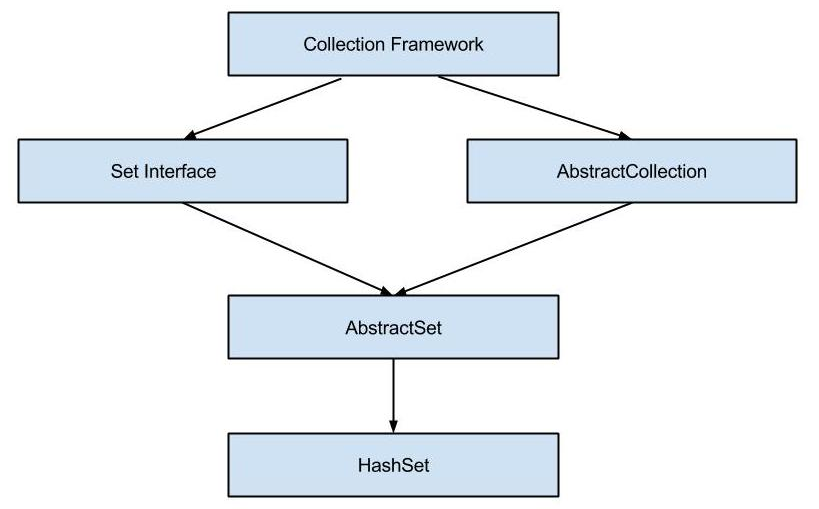Java HashSet class implements the Set interface, backed by a hash table(actually a HashMap instance). If does not offer any guarantees as to the iteration order, and allows null element.
Table of Contents 1. HashSet Hierarchy 2. HashSet Features 3. HashSet Constructors 4. HashSet Methods 5. HashSet Example 6. HashSet Usecases 7. HashSet Performance 8. Conclusion
1. HashSet Hierarchy
The HashSet class extends AbstractSet class which implements Set interface. The Set interface inherits Collection and Iterable interfaces in hierarchical order.
public class HashSet<E> extends AbstractSet<E>
implements Set<E>, Cloneable, Serializable
{
//implementation
}

2. HashSet Features
- It implements
SetInterface. - Duplicate values are not allowed in HashSet.
- One NULL element is allowed in HashSet.
- It is un-ordered collection and makes no guarantees as to the iteration order of the set.
- This class offers constant time performance for the basic operations(add, remove, contains and size).
- HashSet is not synchronized. If multiple threads access a hash set concurrently, and at least one of the threads modifies the set, it must be synchronized externally.
- Use Collections.synchronizedSet(new HashSet()) method to get the synchronized hashset.
- The iterators returned by this class’s iterator method are fail-fast and may throw
ConcurrentModificationExceptionif the set is modified at any time after the iterator is created, in any way except through the iterator’s ownremove()method. - HashSet also implements Searlizable and Cloneable interfaces.
2.1. Initial Capacity
The initial capacity means the number of buckets (in backing HashMap) when hashset is created. The number of buckets will be automatically increased if the current size gets full.
Default initial capacity is 16. We can override this default capacity by passing default capacity in it’s constructor HashSet(int initialCapacity).
2.2. Load Factor
The load factor is a measure of how full the HashSet is allowed to get before its capacity is automatically increased. Default load factor is 0.75.
This is called threshold and is equal to (DEFAULT_LOAD_FACTOR * DEFAULT_INITIAL_CAPACITY). When HashSet elements count exceed this threshold, HashSet is resized and new capacity is double the previous capacity.
With default HashSet, the internal capacity is 16 and the load factor is 0.75. The number of buckets will automatically get increased when the table has 12 elements in it.
3. HashSet Constructors
The HashSet has four types of constructors:
- HashSet(): initializes a default HashSet instance with the default initial capacity (16) and default load factor (0.75).
- HashSet(int capacity): initializes a HashSet with a specified capacity and default load factor (0.75).
- HashSet(int capacity, float loadFactor): initializes HashSet with specified initial capacity and specified load factor.
- HashSet(Collection c): initializes a HashSet with same elements as the specified collection.
4. HashSet Methods
- public boolean add(E e) : adds the specified element to the Set if not already present. This method internally uses equals() method to check for duplicates. If element is duplicate then element is rejected and value is NOT replaced.
- public void clear() : removes all the elements from the hashset.
- public boolean contains(Object o) : returns
trueif the hashset contains the specified element, othrweisefalse. - public boolean isEmpty() : returns
trueif hashset contains no element, otherwisefalse. - public int size() : returns the number of elements in the hashset.
- public Iterator<E> iterator() : returns an iterator over the elements in this hashset. The elements are returned from iterator in no specific order.
- public boolean remove(Object o) : removes the specified element from the hashset if it is present and return
true, else returnsfalse. - public boolean removeAll(Collection<?> c) : remove all the elements in the hashset that are part of the specified collection.
- public Object clone() : returns a shallow copy of the hashset.
- public Spliterator<E> spliterator() : creates a late-binding and fail-fast Spliterator over the elements in this hashset.
5. Java HashSet Example
5.1. HashSet add, remove, iterator example
//1. Create HashSet
HashSet<String> hashSet = new HashSet<>();
//2. Add elements to HashSet
hashSet.add("A");
hashSet.add("B");
hashSet.add("C");
hashSet.add("D");
hashSet.add("E");
System.out.println(hashSet);
//3. Check if element exists
boolean found = hashSet.contains("A"); //true
System.out.println(found);
//4. Remove an element
hashSet.remove("D");
//5. Iterate over values
Iterator<String> itr = hashSet.iterator();
while(itr.hasNext())
{
String value = itr.next();
System.out.println("Value: " + value);
}
Program Output.
[A, B, C, D, E] true Value: A Value: B Value: C Value: E
5.2. Convert HashSet to Array Example
Java example to convert a hashset to array using toArrray() method.
HashSet<String> hashSet = new HashSet<>();
hashSet.add("A");
hashSet.add("B");
hashSet.add("C");
hashSet.add("D");
hashSet.add("E");
String[] values = new String[hashSet.size()];
hashSet.toArray(values);
System.out.println(Arrays.toString(values));
Program Output.
[A, B, C, D, E]
5.3. Convert HashSet to ArrayList Example
Java example to convert a hashset to arraylist using Java 8 stream API.
HashSet<String> hashSet = new HashSet<>();
hashSet.add("A");
hashSet.add("B");
hashSet.add("C");
hashSet.add("D");
hashSet.add("E");
List<String> valuesList = hashSet.stream().collect(Collectors.toList());
System.out.println(valuesList);
Program Output.
[A, B, C, D, E]
6. HashSet Usecases
HashSet is very much like ArrayList class. It additionally restrict the duplicate values. So when we have a requirement where we want to store only distinct elements, we can choose HashSet.
A real-life usecase for HashSet can be storing data from stream where the stream may contain duplicate records, and we are only interested in distinct records.
Another usecase can be finding distinct words in a given sentence.
7. Java HashSet Performance
- HashSet class offers constant time performance of O(1)for the basic operations(add, remove, contains and size), assuming the hash function disperses the elements properly among the buckets.
- Iterating over this set requires time proportional to the sum of the HashSet instance’s size (the number of elements) plus the”capacity” of the backing HashMap instance (the number ofbuckets). Thus, it’s very important not to set the initial capacity too high (or the load factor too low) if iteration performance is important.
8. Conclusion
From above discussion, it is evident that HashSet is very useful collection class in cases where we want to handle duplicate records. It provided predictable performance for basic operations.
Drop me your questions related to HashSet in Java in comments.
Happy Learning !!
Reference:

Comments